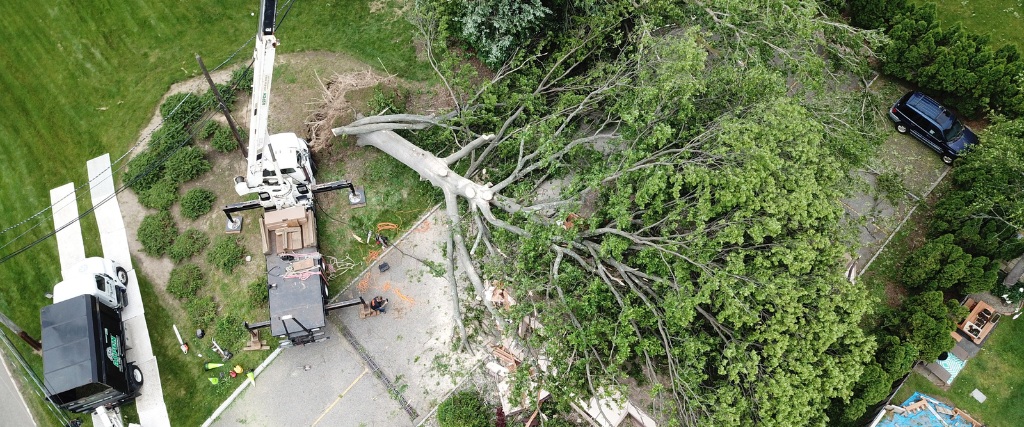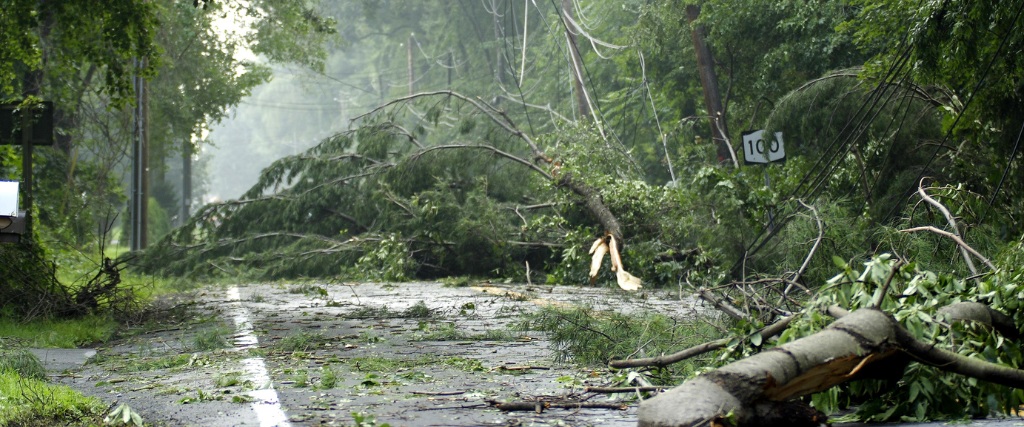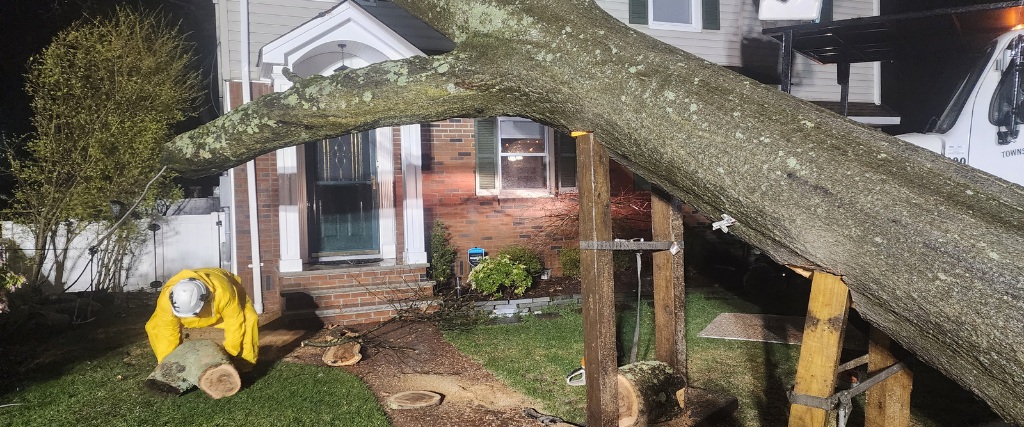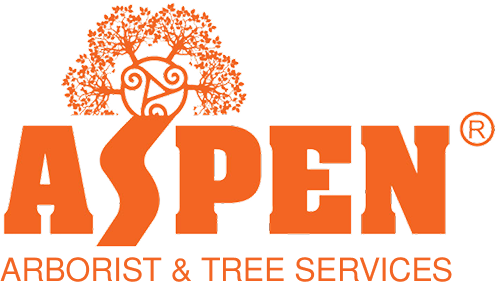When hurricane winds finally die down across Northern New Jersey, the real challenge begins. From Montclair’s historic tree-lined streets to Clifton’s densely packed neighborhoods, homeowners face the daunting task of assessing storm damage safely. The critical first 24 hours after a hurricane can mean the difference between a manageable cleanup and a dangerous situation that puts lives and property at risk.
Recent severe thunderstorms that prompted a state of emergency in New Jersey this July served as a stark reminder of nature’s power, just as Hurricane Ida taught us devastating lessons about post-storm tree hazards in 2021. Those events showed us that knowing what to do immediately after a hurricane isn’t just helpful – it’s essential for protecting your family and home.
Key Takeaways
- Focus on immediate personal safety and property hazard identification before attempting any tree assessment.
- Any tree touching power lines, leaning more than 15 degrees, or blocking emergency access requires professional evaluation.
- Photograph all tree damage from multiple angles within 24 hours, but only after ensuring your safety.
- Know your county’s emergency management numbers and PSE&G outage reporting (1-800-436-7734) before you need them.
- Always coordinate with PSE&G before any tree work near electrical lines – even “dead” lines can be energized.
- Post-hurricane stress can weaken trees for years, requiring ongoing ISA Certified Arborist monitoring.
Hours 0-6: Immediate Safety Assessment
The moment it’s safe to step outside after hurricane-force winds subside, your first priority isn’t assessing tree damage – it’s ensuring your family’s immediate safety. Before you even think about that large oak leaning toward your Caldwell home or the maple branches scattered across your Cedar Grove driveway, you need to establish a safe perimeter around your property.
Personal Safety Comes First
Walk your property systematically, but stay alert for these immediate dangers that require you to stop and call for help:
- Any tree or large branch touching power lines (call PSE&G at 1-800-436-7734 immediately)
- Trees leaning more than 15 degrees toward structures, vehicles, or walkways
- Cracked or split tree trunks that could fail without warning
- Hanging branches caught in other trees that could fall unexpectedly
- Gas odors near damaged trees (evacuate and call 911)
Remember, Northern New Jersey’s elevation changes and narrow lot lines create unique wind patterns that can make tree failures unpredictable. What looks stable in Montclair’s historic district might be hanging by a thread due to root damage you can’t see.
When to Leave the Area Immediately
If you discover any of these conditions during your initial assessment, evacuate the immediate area and contact emergency services:
- Multiple large, downed trees blocking all exits from your property
- Trees or branches touching your home’s roof or siding
- Electrical lines down in your yard (assume all downed lines are live)
- Gas odors combined with tree damage near utility meters
For situations that aren’t immediately life-threatening but still require professional assessment, you’re in the zone where Licensed Tree Expert emergency services become critical.

Situations like downed trees require professional removal from a company with extensive equipment and training.
Hours 6-12: Professional vs. DIY Assessment
Once you’ve secured immediate safety and contacted emergency services for any urgent hazards, you face a crucial decision: what can you safely assess yourself, and when do you need professional help? This is where understanding the difference between Licensed Tree Experts and homeowner capabilities can literally save your life.
“After Hurricane Ida, we saw far too many homeowners put themselves at risk trying to handle hazardous tree damage on their own. What might look like a simple cleanup could actually be a tree under dangerous tension or a structural failure ready to give way. An LTE can mean the difference between a safe resolution and a life-threatening accident.” – Casey Walentowicz, Licensed Tree Expert #689, Aspen Tree Service
What Homeowners Can Safely Assess
You can handle basic visual inspection of these lower-risk situations:
- Small branches (under 2 inches in diameter) that have cleanly broken off
- Leaves and minor debris in yards and driveways
- Obvious surface root damage around smaller trees
- Fence damage from small falling branches
However, during severe weather events, like the storms that caused widespread closures and delays across New Jersey, even seemingly minor damage can mask serious structural problems that require professional assessment.
When a Licensed Tree Expert Assessment Is Required
New Jersey law requires Licensed Tree Expert evaluation for complex tree work, and post-hurricane conditions make this even more critical. For emergency situations, professional emergency tree services can provide 24/7 response when you need it most. Call an LTE immediately for:
- Any tree or branch touching or near power lines
- Trees leaning more than 15 degrees from vertical
- Visible root ball exposure or lifting
- Cracked or split trunks, especially on mature trees
- Trees blocking emergency vehicle access
- Multiple tree failures on your property
- Trees threatening structures or neighboring properties
TRAQ Certification Difference: Tree Risk Assessment Qualified (TRAQ) certification allows arborists to identify structural defects that untrained individuals miss. In post-hurricane conditions, these hidden defects can be deadly. At Aspen Tree Service, our TRAQ-certified arborists understand how wind loading, soil saturation, and structural damage interact – knowledge that takes years to develop and can’t be learned from YouTube videos.
Hours 12-18: Municipal Considerations by County
Northern New Jersey’s complex municipal landscape means tree damage response varies significantly by location. Each county and municipality has specific protocols, permit requirements, and emergency contacts that can affect your recovery timeline.
Essex County: Historic Districts and Mature Canopies
Montclair, Caldwell Borough, and Cedar Grove face unique challenges due to their mature tree canopies and historic home layouts. Many properties feature large oaks and maples planted 50-100 years ago, often closer to structures than modern setback requirements would allow.
In these communities, post-hurricane tree assessment must consider:
- Narrow lot lines that increase neighbor-to-neighbor risk
- Vintage architecture that may be more vulnerable to tree impact
- Historic district regulations that could affect tree removal permits
- Underground utilities that may be compromised by root damage
Bergen County: Elevation and Wind Exposure
Higher elevation communities in Bergen County face increased wind exposure during storms, and many neighborhoods have utility lines running through tree canopies. This combination creates particular challenges for post-hurricane assessment.
PSE&G coordination becomes even more critical in Bergen County because of the extensive overhead line network. Always report tree-power line contact to PSE&G at 1-800-436-7734 before calling tree services.
Passaic County: Dense Urban Forest Challenges
Clifton and surrounding Passaic County communities face unique post-hurricane challenges due to their dense residential areas and varying elevations near major highways. The wind tunnel effects created by Route 3 and Garden State Parkway corridors can cause unexpected tree failure patterns.
Many properties in Passaic County have limited access for emergency equipment, making professional crane operations necessary for safe tree removal. This is why choosing a Licensed Tree Expert with proper equipment access becomes critical.
Morris County: Terrain and Access Considerations
Morris County’s steep terrain and larger properties can sustain significant tree damage that’s harder to assess and more expensive to address. The combination of elevation changes and mature landscaping creates domino-effect risks where one falling tree can trigger multiple failures.

When trees bring down power lines, always contact PSE&G before attempting any tree work.
Hours 18-24: Insurance Documentation and Recovery Planning
As you approach the 24-hour mark after hurricane impact, your focus shifts from immediate safety to documentation and recovery planning. This phase requires balancing thorough documentation with continued safety awareness, as damaged trees can still fail days after the initial storm.
Insurance Documentation Requirements
Most homeowner’s insurance policies require prompt notification of storm damage, but documentation quality can significantly affect claim outcomes. Here’s what insurance adjusters need to see:
- Wide-angle photos showing the overall property damage context
- Close-up images of specific tree damage, including root exposure
- Multiple angles of each damaged tree or fallen branch
- Property damage photos showing tree impact on structures, vehicles, or landscaping
- Before photos, if available, showing the tree’s pre-storm condition
Safety Warning: Only photograph damage from safe distances. Never climb on debris piles or approach unstable trees for better photo angles. Insurance companies would rather have distant photos than injured claimants.
Planning for Long-Term Tree Health Recovery
Hurricane damage weakens trees for years after the initial impact. Even trees that survive the storm without obvious damage may have suffered root injury or bark damage that predisposes them to future failure.
This is where an ongoing ISA Certified Arborist consultation becomes valuable. Post-hurricane tree health management should include:
- Annual risk assessments for the first three years after hurricane damage
- Proper pruning to remove storm-damaged branches and reduce future wind resistance
- Root zone management to address soil compaction from cleanup equipment
- Fertilization programs to help trees recover from stress
- Preventive treatment for opportunistic pests and diseases that target stressed trees
PRO TIP: Trees can show delayed stress reactions 1-3 years after hurricane damage. What looks healthy immediately after a storm might decline over time due to root damage or bark injuries that aren’t immediately visible.
Beyond the First 24 Hours: Professional Recovery Partnership
The first 24 hours after a hurricane are just the beginning of your property’s recovery process. While this checklist helps you navigate the immediate aftermath safely, long-term tree health and property protection require ongoing professional partnership.
Since Hurricane Ida’s devastating impact on Northern New Jersey in 2021, we’ve learned that post-storm tree care isn’t just about cleanup – it’s about building resilience for future storms. Trees weakened by hurricane damage become more vulnerable to subsequent weather events, creating ongoing risks that require professional monitoring.
The investment in proper post-hurricane tree care pays dividends in reduced insurance claims, improved property values, and most importantly, family safety. When you’re dealing with mature trees that have weathered decades in Montclair’s historic neighborhoods or Clifton’s established communities, professional expertise becomes essential for preserving these valuable assets.
Frequently Asked Questions
Look for obvious signs like leaning more than 15 degrees, exposed roots, cracked trunks, or hanging branches. However, many hazards aren’t visible to untrained eyes. Licensed Tree Experts with TRAQ certification can identify structural defects that create long-term risks. When in doubt, have a professional assessment – it’s much less expensive than property damage or injury.
Always call PSE&G first (1-800-436-7734) if trees are touching power lines or if you have a power outage. They need to secure the electrical hazards before tree work can begin. Once PSE&G clears electrical issues, Licensed Tree Experts can safely remove the tree debris. Never attempt tree work near power lines yourself – even “dead” lines can be re-energized remotely.
Emergency tree removal addresses immediate safety hazards like trees threatening structures or blocking emergency access. It often requires 24/7 availability, specialized equipment, and coordination with utilities or emergency services. Regular tree service can be scheduled at your convenience and focuses on health and aesthetics rather than immediate danger.
Take photos from multiple angles showing the damaged tree, any property damage it caused, and the overall context of your property. Include close-ups of root damage, trunk cracks, or branch failures. Document the date and time of photos. Most importantly, only photograph from safe distances – never climb on debris or approach unstable trees for better angles.
You can safely remove small branches (under 2 inches in diameter) that have cleanly broken off and fallen to the ground. However, avoid cutting anything still attached to trees, even small branches, as they may be under tension and can snap back dangerously. Never use chainsaws on storm-damaged trees unless you’re professionally trained – the unpredictable stresses make this extremely hazardous.
Wait until winds drop below 35 mph and it’s safe to be outdoors. Even then, limit your initial assessment to visual inspection from safe distances. Damaged trees can continue falling for days after a storm due to progressive failure of weakened wood or roots. Professional assessment should happen within 24-48 hours for insurance documentation, but safety always comes first.

Professional emergency tree removal requires specialized equipment and Licensed Tree Expert oversight for safety.
Need Emergency Tree Service? Northern NJ’s Licensed Experts Are On Call 24/7
When hurricane damage threatens your Northern New Jersey property, you need Licensed Tree Expert response you can trust. Aspen Tree Service has been protecting families and properties across Essex, Bergen, Passaic, and Morris counties since 1986.
Don’t wait for a dangerous situation to become tragic.
Call 201-939-8733 for immediate emergency tree service, or request an emergency consultation online.
Available 24/7 for emergency response across Northern New Jersey






